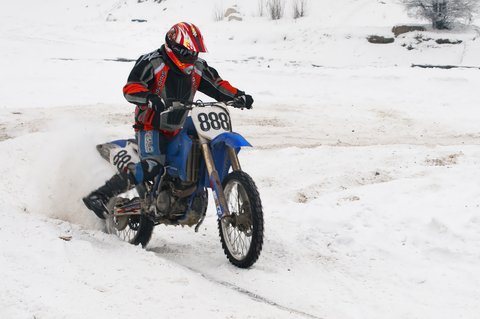The term “winterize” may have different connotations from one motorcyclist to another. To most, it means doing the appropriate tuning and putting the bike away safely for the cold months. For others, it means getting your bike prepped to take on the winter onslaught and keep it rolling all the way through to springtime.
Here are some essential tips to keep your bike running strong through the winter.
Necessary Maintenance
For safety purposes, the most important change to make for anyone who plans to ride through a northern winter is tires. A good deep tread is a must for cold conditions. You may very possibly get away with keeping used tires on, but if they show any signs of wear, keep them off the unforgiving winter roads.
Tire heat also takes longer to build up in the cold. They will warm up after being on the road for a short period of time, but until then it is important to be easy on braking, acceleration and lean angles. There are methods to heating them up like quickly accelerating and braking, but this could cause skidding and unnecessary tire wear.
To keep warm, it’s never a bad idea to use a tall windscreen. While any windscreen is better than none, oftentimes stock screens won’t fully keep the wind off you. Several aftermarket screens are available for all bikes, but if you’re really tall you may need a custom-made product.
Some bikes may require a change to cold-running oil, but sometimes that isn’t the case. Read up on your specific model. Also, if the bike is liquid cooled, it is never a bad idea to check on the freshness of the antifreeze.
Keeping The Body Warm
Although some changes will have to be done to the bike, the more important tweaks will be to your riding gear itself.
Layering is the name of the game. You can buy all sorts of pieces of brand name motorcycling gear costing hundreds of dollars each, but none of that matters if you don’t have each essential layer.
When temperatures dip near and below freezing, it is important to have a heat-trapping and sweat-wicking base layer. This can be a highly effective skin-tight baselayer or a simple pair of long underwear and thermal long sleeve shirt.
The middle layer should be something that will further insulate without being too bulky, like a thin sweatshirt or zip-up. The outer layer should be probably the most expensive part of your riding gear. You need something that will combat the elements and retain warmth without being too bulky. Several companies make winter outer layers, and it’s always a good idea to opt for a product made with Gore-Tex for waterproofing and insulation. Several motorcycling boots use Gore-Tex as well, and they are made to keep circulation to your feet, grip the pegs and feel the shifter and rear brake pedal.
When it comes to gloves, buying motorcycling specific gloves is a good option, because they are the only type that are made to accommodate rider comfort, grip and protection. Gauntlet gloves that cover the wrist and have high quality insulation are a good idea. For added protection from the cold, a thin base layer glove will retain warmth. If that sounds too bulky, there are grip heating systems that run off the motorcycle’s battery. Wind guards on the bars will help a ton, too.
Above All Else, Be Careful
Most of the necessary winter changes take little time and effort and will pay off in the long run. Comfort and bike performance are important for what they are, but it’s their effect on mental clarity that matters most. If you’re freezing cold and fighting a hard-riding bike, you are opening yourself up to the possibilities of disaster.








